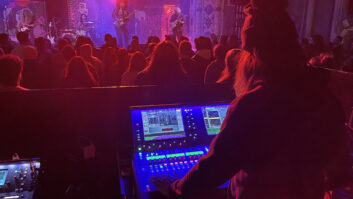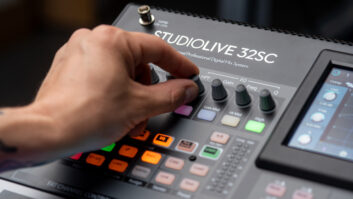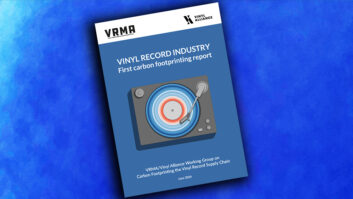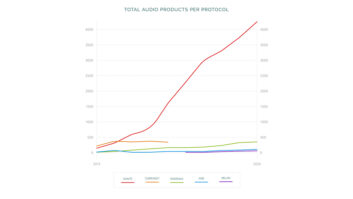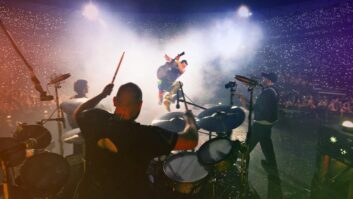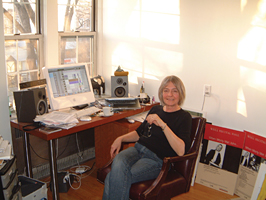
Joan La Barbara in His & Hers home studios
Photos: David Weiss
His and hers studios? We’ve heard of such a distinction for bathrobes, luggage and even Corvettes, but not audio facilities — not until we met experimental vocalist/chanteuse Joan La Barbara at a swank New York City party, that is.
It turns out that a His & Hers music production combo is exactly what La Barbara (www.joanlabarbara.com) and her husband, electronic music founding father Morton Subotnick (www.mortonsubotnick.com) are running in their digs. Set in the heart of Greenwich Village, their roomy apartment is home to a friendly old dog, an occasionally talkative parrot and separate-but-equal studios that allow these two musical pioneers to get wired, inspired and collaborate as needed.
“His” studio is an unassumingly compact surround-sound setup that at first glance gives zero indication of being operated by the man who many credit as being the co-inventor of the modern synthesizer. Subotnick’s work in the early 1960s to bring the Buchla 100 Series modular synth into existence is the stuff of legend (learn more from Remix writer Bill Murphy’s article at remixmag.com/artists/electronic/remix_morton_subotnick/), and subsequent works such as Silver Apples of the Moon, Touch and Sidewinder are considered classical/electronic classics.
Today, instead of a wall-to-wall-to-wall behemoth of a Buchla, Subotnick, at an extremely youthful 75, is perfectly content to be based on a G5 and surrounded by quadraphonic Mackie FR monitors with a Samson sub. “Originally, I was going to be in the big room,” says Subotnick, gesturing over to the larger part of the space, “but I have two or three assistants, so they have the big room and I have my little sanctuary here. For basic monitoring, I don’t have to blast it and the subwoofer works quite well. It’s really just a small space — but it’s just me.”

Mort Subotnick in their His & Hers home studios
No DAW out there has truly satisfied the pioneering Subotnick. Instead, his studio center of choice is the PreSonus FireStudio. “I must have five different FireWire devices — this one I like the best because it has the best software mixer in it,” he explains. “It’s quite well-designed. What I don’t like about the others is that they assume that you want to do x, y or z, and I never do what is assumed. This is a matrix, so I can do anything I want with it.”
Right now, the projects his studio is supporting include an updating of his 1975 work Until Spring called Until Spring Re-visited, ongoing development of his music learning curriculum “Creating Music” (www.creatingmusic.com) and the creation of a collection of Soundfonts (“more than a full-time job”). Also on the docket is an extension of his famous “ghost pieces” for live performance, as well as myriad other musical adventures.
Decades after his own tireless efforts led to the vast array of soft synthesis options available to bedroom producers today, Subotnick seems pleased with how his innovations have played out in modern music production. “I sort of did have a vision of where we’d be,” he says. “I didn’t know I’d be seeing it in 2008 — I didn’t know if I’d make it to the 21st century! I was playing on my clarinet, for example, and I couldn’t see why I would spend my life using electronics to design what I could already play; I thought people would want to be creative and express what they couldn’t play [with existing traditional instruments].
“But now with the computer, people are creating what they couldn’t play by making laptop orchestras. In the last 10 years, computers have gotten smaller, quicker and cheaper, and a lot of people’s home studios look like mine now. This looks almost like a prototype of a lot of home studios, and that’s what I imagined in 1960.”
Go back into the living room, walk past the muttering parrot, hang a left and you’re into the “Hers” section of the pad. This is sonic HQ for La Barbara, as much of a pioneer with the human voice as Subotnick has been with synthesis. La Barbara first started making waves in the mid-’70s with the Philip Glass Ensemble, and went on to collaborate with the likes of John Cage, Robert Ashley and, of course, Subotnick, her spouse since 1979. Along the way, her development of advanced vocal techniques has gone way beyond singing, making her mark with glottal sounds, grunts, clicks, multiphonic voicings, falsettos and circular singing in celebrated works such as Sound Paintings and Shamansong.
Like Subotnick, La Barbara continues her trailblazing work with a relatively streamlined setup. Next to the west-facing window of the sun-drenched room resides an Apple G5 connected to a Digidesign Mbox, a pair of M-Audio Project Studio 5 monitors and a Yamaha Clavinova digital piano.
Aside from this recording setup and an unlimited imagination, a Beyerdynamic M88NC microphone is all the vocal adventurer really needs, wrapping the mic up after she’s in the studio and promptly taking it out for live use. “I recently did a piece called ‘Shimmer,’ which is a recording of an opera in progress,” she explains. “When I did the playback and sang over that, it was so transparent you couldn’t tell if what you were hearing was live or the recorded material. What I really like to do with live and recorded sound is mix my voice so it can be immersed into the live texture. Using the same mic for everything helps contribute to that sense of mystery.”
Looking out on the Avenue of the Americas, La Barbara remarks that her current vocal projects are focusing inward. “I’m working on what I think of as interior sounds — sounds inside one’s head,” says La Barbara. “The challenge to me is to record these sounds that are not huge, not projected. They’re more intimate and personal kinds of sounds. I’m able to work on these very quiet sounds because of the nature of the technology and how it’s advanced at this point: You can get sonic blackness, which is something you could never get with analog. The idea that you can get this with voice the same way that painters talk about negative space is something I’m finding a real challenge to incorporate into the sound.”
Even though La Barbara and Subotnick’s studios are interconnected via Ethernet, there are still important boundaries that separate the His & Hers studios of Greenwich Village. “If one of us sees the need, we’ll come in and comment [on what the other is working on], but we don’t comment unless asked — I think that’s a good rule of thumb,” she says. “That’s because composers have their own individual ideas. But if I’m stuck on something and I want an opinion on how a certain sound mixes with another sound, I’ll ask him to come in. I think having that kind of availability of another composer to bounce things off of is really marvelous. He’s certainly more adept at electronic modification of sounds, and I’ve done a whole lot with the voice and the layering of materials.”
Even as an electronics adventurer nearly 50 years ago, one of Subotnick’s primary goals was not just to elevate experimental musical possibilities, but also make the process of its creation available in every home. Looking at Subotnick and La Barbara’s everyday His & Hers studios tucked neatly into their New York City apartment, there’s no question he’s succeeded very nicely on that count. “A lot of what I was doing in those days has become a feasible reality,” he says. “I was thinking of a sound easel in your living room, a cheap little thing you could create with. Now it seems to be there, and I’m thrilled that I’m not only seeing it, but in perfect health and living it.”
Send New York news to David Weiss:
david@dwords.com.


